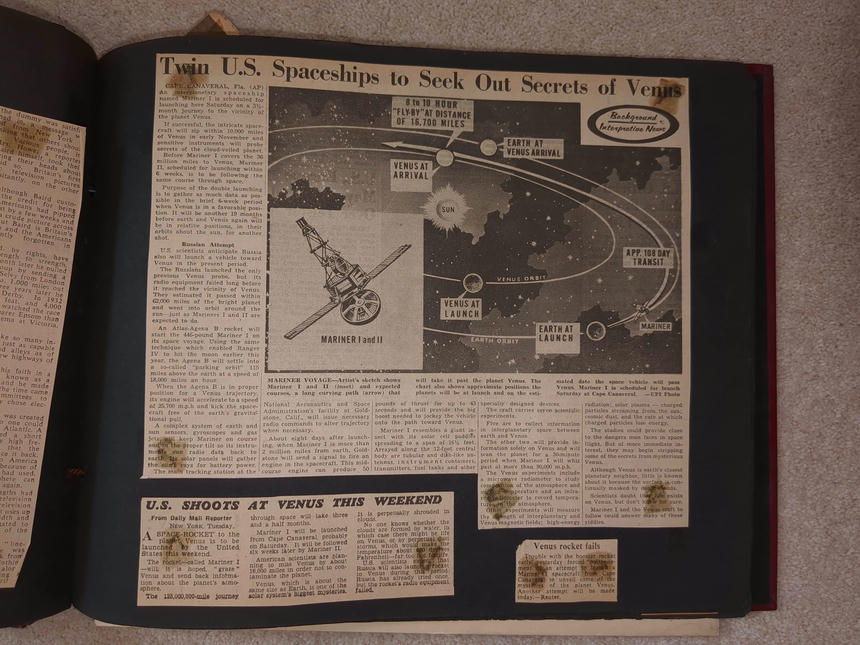Scrapbook 2: Jul 1962 — Mariner, Venus

Twin U.S. Spaceships to Seek Out Secrets of Venus
CAPE CANAVERAL, Fla. (AP) An interplanetary spaceship named Mariner I is scheduled for launching here Saturday on a 3½-month journey to the vicinity of the planet Venus.
If successful, the intricate spacecraft will zip within 10,000 miles of Venus in early November and sensitive instruments will probe secrets of the cloud-veiled planet.
Before Mariner I covers the 36 million miles to Venus, Mariner II, scheduled for launching within 6 weeks, is to be following the same course through space.
Purpose of the double launching is to gather as much data as possible in the brief 6-week period when Venus is in a favorable position. It will be another 19 months before earth and Venus again will be in relative positions, in their orbits about the sun, for another shot.
Russian Attempt
U.S. scientists anticipate Russia also will launch a vehicle toward Venus in the present period.
The Russians launched the only previous Venus probe, but its radio equipment failed long before it reached the vicinity of Venus. They estimated it passed within 62,000 miles of the bright planet and went into orbit around the sun—just as Mariners I and II are expected to do.
An Atlas-Agena B rocket will start the 446-pound Mariner I on its space voyage. Using the same technique which enabled Ranger IV to hit the moon earlier this year, the Agena B will settle into a so-called “parking orbit” 115 miles above the earth at a speed of 18,000 miles an hour.
When the Agena B is in proper position for a Venus trajectory, its engine will accelerate to a speed of 25,700 m.p.h and kick the spacecraft free of the earth’s gravitational pull.
A complex system of earth and sun sensors, gyroscopes and gas jets will keep Mariner on course and in the proper tilt so its instruments can radio data back to earth. Its solar panels will gather the sun’s rays for battery power.
The main tracking station at the National Aeronautics and Space Administration’s facility at Goldstone, Calif., will issue necessary radio commands to alter trajectory when necessary.
About eight days after launching, when Mariner I is more than 2 million miles from earth, Goldstone will send a signal to fire an engine in the spacecraft. This mid-course engine can produce 50 pounds of thrust for up to 43 seconds and will provide the big boost needed to jockey the vehicle onto the path toward Venus.
Mariner I resembles a giant insect with its solar cell paddles spreading to a span of 16½ feet. Arrayed along the 12-foot central body are tubular and dish-like antennas, instrument containers, transmitters, fuel tanks and other specially designed devices.
The craft carries seven scientific experiments.
Five are to collect information in interplanetary space between earth and Venus.
The other two will provide information solely on Venus and will scan the planet for a 30-minute period when Mariner I will whiz past at more than 90,000 m.p.h.
The Venus experiments include a microwave radiometer to study composition of the atmosphere and surface temperature and an infrared radiometer to record temperatures in the atmosphere.
Other experiments will measure the strength of interplanetary and Venus magnetic fields; high-energy radiation; solar plasma — charged particles streaming from the sun; cosmic dust, and the rate at which charged particles lose energy.
The studies could provide clues to the dangers man faces in space flight. But of more immediate interest, they may begin stripping some of the secrets from mysterious Venus.
Although Venus is earth’s closest planetary neighbor, little is known about it because the surface is continually masked by dense clouds.
Scientists doubt that life exists on Venus, but don’t know for sure.
Mariner I and the Venus craft to follow could answer many of these riddles.
MARINER VOYAGE—Artist’s sketch shows Mariner I and II (inset) and expected courses, a long curving path (arrow) that will take it past the planet Venus. The chart also shows approximate positions the planets will be at launch and on the estimated date the space vehicle will pass Venus. Mariner I is scheduled for launch Saturday at Cape Canaveral. —UPI Photo
U.S. SHOOTS AT VENUS THIS WEEKEND
From Daily Mail Reporter NEW YORK, Tuesday.
A SPACE-ROCKET to the planet Venus is to be launched by the United States this weekend.
The rocket—called Mariner I—will, it is hoped, “graze” Venus and send back information about the planet’s atmosphere.
The 125,000,000-mile journey through space will take three and a half months.
Mariner I will be launched from Cape Canaveral, probably on Saturday. It will be followed six weeks later by Mariner II.
American scientists are planning to miss Venus by about 16,000 miles in order not to contaminate the planet.
Venus, which is about the same size as Earth, is one of the solar system’s biggest mysteries. It is perpetually shrouded in clouds.
No one knows whether the clouds are formed by water, in which case there might be life on Venus, or by perpetual dust storms, which would make the temperature about 600 degrees Fahrenheit—far too hot for life.
U.S. scientists expect that Russia will also launch a rocket to Venus during this period. Russia has already tried once, but the rocket’s radio equipment failed.
Venus rocket fails
Trouble with the booster rocket early yesterday forced postponement of an attempt to launch a Mariner I spacecraft from Cape Canaveral to unveil some of the mysteries of the planet Venus. Another attempt will be made today.—Reuter.